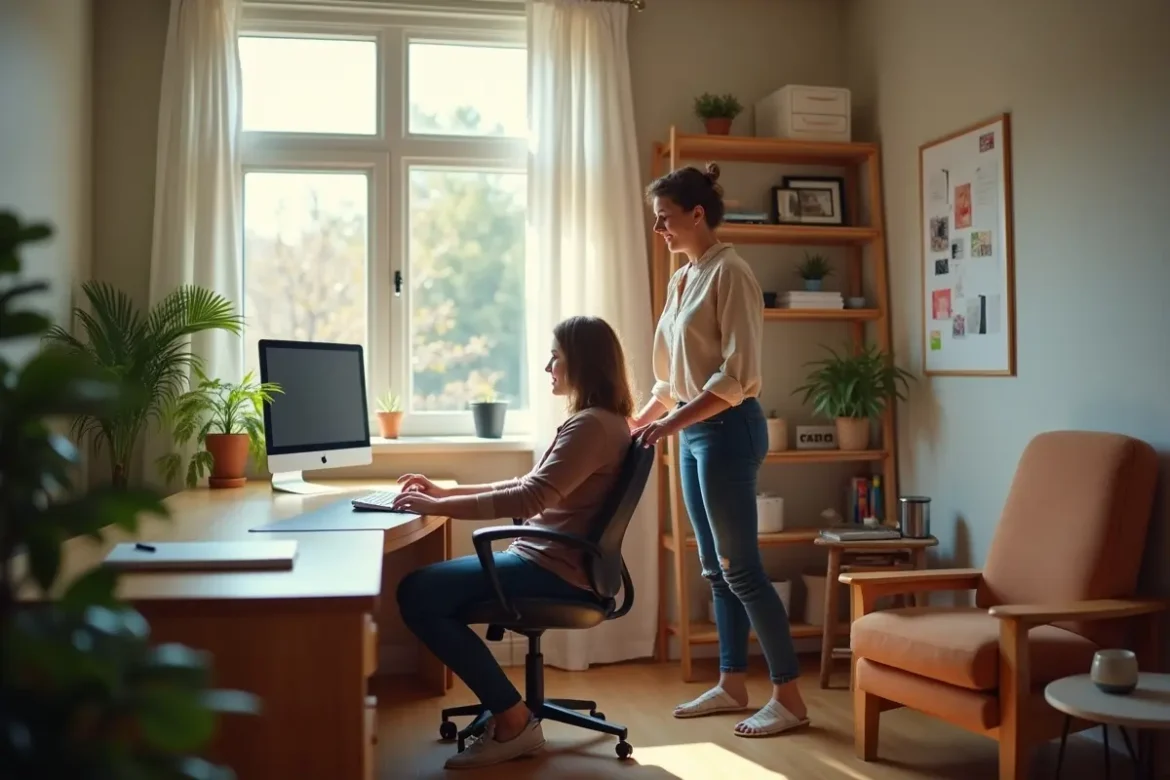
Setting up a workspace without a spare room? Here’s how.
By 2025, 36.2 million Americans will be working remotely. That’s a huge increase from before the pandemic. But…
It’s also true that most remote workers don’t have an extra room in their home to turn into an office.
The good news is that you don’t need a large space to set up an efficient and stylish home office. In fact, you can create a surprisingly functional home office space, even if you only have a small corner.
Contents
- 1 Why Small Space Home Offices Work Better Than You Think
- 2 Finding Your Perfect Office Spot (Even When There Isn’t One)
- 3 Must-Have Furniture That Won’t Eat Your Space
- 4 Smart Storage Solutions That Actually Work
- 5 Setting Up Your Tech Without The Cable Chaos
- 6 Creating Boundaries In Shared Spaces
- 7 Final Thoughts
This complete guide to home office setups for small spaces covers:
- Why smaller home offices can be more productive than large ones
- How to find the right spot for your home office
- Must-have space-saving furniture and tech for small spaces
- Smart storage solutions to keep things organized
- Cable management and lighting tips for small offices
Plus you can download our free home office setup checklist to walk you through the process step-by-step.
Why Small Space Home Offices Work Better Than You Think
Working in a small home office is not a disadvantage.
You might think a small space will distract you. Or that you’ll miss large pieces of furniture. But setting up a home office in a small space can actually be more efficient.
Everything you need is close at hand. There are no extra steps or distractions around the corner.
When you have limited space, you’re naturally more intentional about the items you add to your office.
A virtual office space can be used as an extension of your workspace. It gives you a professional business address without taking up any room in your home.
Even design experts say multifunctional spaces are the current home office trend. 77% of them agree that flexible spaces are the biggest home office trend in 2022.
Small home offices work better for these reasons:
- They’re easier to keep clean and decluttered.
- You have less space to set up furniture.
- They’re more intentional because you can only add what you absolutely need.
The average size for a home office is 100 to 150 square feet. So don’t think that your home office is too small. You might be working with the standard home office size without even realizing it.
Finding Your Perfect Office Spot (Even When There Isn’t One)
Step one to setting up a home office isn’t buying furniture.
It’s scouting out the right place for it.
Grab a measuring tape and go around your house. Look for hidden spaces that are ideal for setting up a home office:
- Corner of your bedroom, away from your bed
- Underneath the stairs
- In a corner of your living room near a window
- Inside a large closet
- End of a hallway
Measure and document all the dimensions of your potential office location. This will help you buy the right furniture to fit. Avoid the mistake of purchasing a desk that’s two inches too wide for the space.
Work Style
Not every home office location is equal.
Do you need to take a lot of video calls? Then choose a spot with a good natural light source and no cluttered background. Are you more of a heads-down, focus-on-the-work type? Then find the quietest and least-trafficked area in your home.
Must-Have Furniture That Won’t Eat Your Space
The right furniture is key to a good home office setup in a small space.
Look for pieces that serve dual functions and match your space’s size.
Desks
Skip the traditional big executive desk. You’re trying to maximize space.
Here are the best desks for a small office:
Wall-mounted desks – These fold away when you’re not working. They’re great if you need a space that can transform from office to open space during the day.
Corner desks – They work with unused corners and maximize every inch.
Floating shelves as desks – Add a floating shelf at the standard desk height. Minimalist and surprisingly workable.
Repurpose existing furniture – Dining table as desk? It’ll work with some desk organizers.
Chairs
The chair you use at your home office is a big deal.
Even in small spaces, your back will thank you for getting a chair that supports your posture. Look for chairs that adjust to your height. Back support is important and a good chair tucks completely under your desk.
Storage
Vertical storage is your friend.
Wall-mounted shelves, pegboards, and vertical file organizers free up desk space while giving you storage.
Smart vertical storage solutions:
- Floating shelves above your workspace
- Wall-mounted file organizers
- Pegboards for handy frequently-used items
- Over-door organizers
Smart Storage Solutions That Actually Work
Yes, smart storage in small spaces is crucial.
You need to store everything you need without making the space feel cluttered. The right home office storage solutions for small spaces follow these rules:
The Declutter Rule
If you add one new office item to your space, one thing has to go. A simple rule but very effective in keeping office supplies from spilling into your living space.
Declutter your workspace for one hour at the end of every week.
Hidden Storage Opportunities
Invest in furniture with hidden storage:
- Desks with built-in drawers
- Ottoman chairs with hidden storage
- File cabinets that double as side tables
Label everything in your home office. There’s no room for mystery storage boxes in a small space.
Digital Over Physical
Scan and file away documents electronically instead of physically storing them. Store files digitally on your computer or in the cloud. Less paper equals more space.
Setting Up Your Tech Without The Cable Chaos
Technology is your best friend and worst enemy when setting up a home office in a small space.
Wire management is crucial in small spaces.
Cable management solutions:
- Cable clips to route cables along desk and window edges
- Under-desk cable trays
- Velcro ties to bundle cables
- Wireless keyboard, mouse, and peripherals
Lighting
Natural light is best but not always an option. Layer lighting with task lighting above your workspace. Ambient lighting can also help to avoid eye strain.
Monitor Setup
If you use an external monitor, try a monitor arm. A monitor arm clamps to your desk and frees up valuable desk space. Position your monitor at arm’s length and at eye level.
Your home office will probably share space with your bedroom, living room, or kitchen. Draw some boundaries to separate work and home life.
Some tricks for sectioning off your workspace:
- Paint the wall behind your desk a different color from the rest of the room
- Set up a room divider or curtain
- Put a small rug down under your desk
Empty your desk at the end of each work day. Creating a hard stop between work and life in your home office.
The Daily Reset Routine
Take five minutes at the end of each day to reset your workspace:
- Clear away dishes and garbage
- File or scan paper work
- Wipe down your desk surface
- Put supplies away
Final Thoughts
Setting up a home office in a small space is a challenge.
But it’s not impossible. Millions of Americans will be working from home by 2025. 91% of experts think the home office has become more important than a spare bedroom.
Focus on:
- Finding the right spot with good natural light
- Investing in space-saving furniture and tech
- Building vertical storage to keep surfaces clear
- Managing cables and tech to reduce visual clutter
- Separating your work area from your home life
The right home office setup combines practicality with style. It’s also personal and tailored to you. Even the smallest home office space should be somewhere you want to spend time.
Try one home office improvement at a time. Little changes can create big results.



